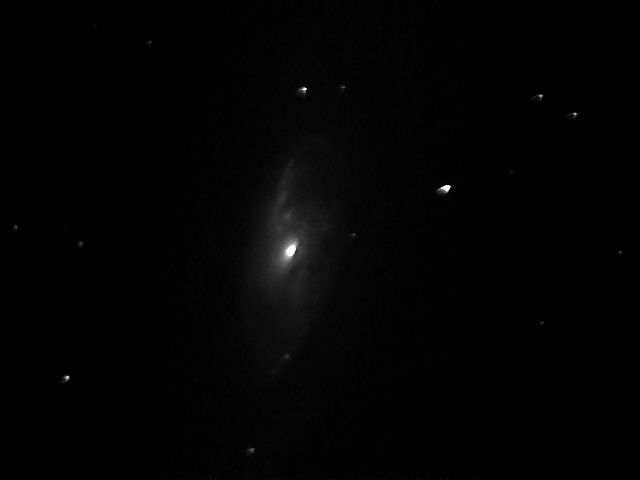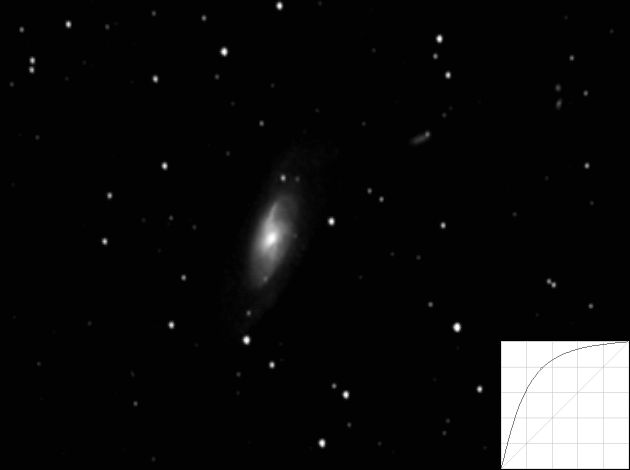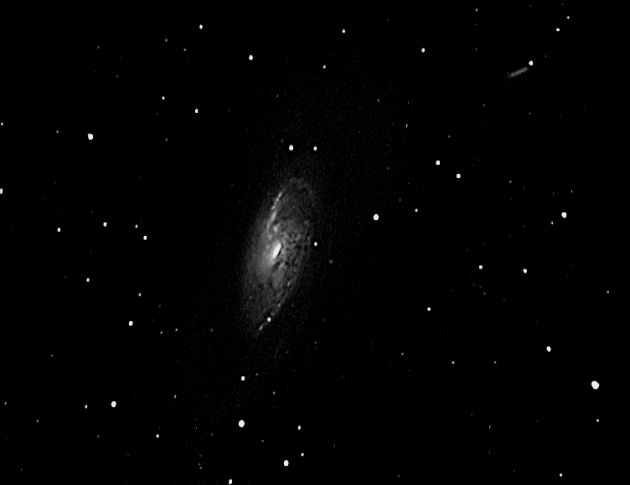

M106 was first observed by Pierre Méchin in 1781, and was added to Messier's list by Helen Hogs in 1947. It is about 30,000 light-years in diameter and around 25 million light-years away. Radio observations suggest that about 36 million solar masses are contained within 54,000 AU (1/12th light-year) of the centre. This high density is one feature of a Seyfert galaxy.
 |
This is my first attempt at this galaxy and I am quite pleased with the result. Date and Time: 8th March 2010 00:22 UT Camera: DMK 21AF04 Telescope: LX200 with 0.33 focal reducer and IR-block filter Capture: ICCapture. Exposure 32.8 sec, gain 786, 271 frames Processing: RegiStax5. 20 frames stacked, histogram 30-180, Some final adjustments in Focus Magic and PhotoImpact. |
||
 |
This is my second attempt at this galaxy, this time taken with my ST80 refractor and MX716 camera. This gives a wider view, and the picture is somewhat deeper, revealing the outer parts of the galaxy which barely showed in the picture above. The object that looks like a small comet to the right of M106 is a small galaxy known as NGC4248. Date and Time: 12th April 2010 21:54 - 22:14 UT Camera: MX716 Telescope: ST80 with skyglow and IR-block filters Capture: star_mx7. Exposure 90 sec, 11 frames Processing: star_mx7, dark subtraction, and initial enhancement factor 25 on each frame. RegiStax5. 10 frames stacked, histogram 8-208, Gaussian wavelet 1(0.2) = 0, gamma curve (see inset). Some final adjustments in Focus Magic and PhotoImpact. |
||
 |
This is my third attempt at this galaxy. The galaxy was at an altitude of 83°, so almost overhead, and I now have guiding implemented so was able to use 60 second exposures without the image moving. The larger aperture of the LX200 combined with the more sensitive camera and improved post-processing has resulted in a much better image. Date and Time: 5th April 2016 23:17 - 23:27 UT Camera: MX716 Telescope: LX200 with 0.33 focal reducer and IR-block filter Capture: star_mx7. Exposure 60 sec, 10 frames Processing: star_mx7, dark subtraction, and non-linear stretch factor 25 on each frame. RegiStax5. 10 frames stacked, RegiStax6. Gaussian wavelets Scheme 9, Brightness -15. |
||
In the 1940s, an American astronomer, Carl Seyfert, carried out a major survey of galaxies and recognised that a small proportion were distinctly different from the rest. They had very bright, compact nuclei and unusual spectra. In most galaxies, the light comes from the stars that they contain and their spectra are those of stars. In these few unusual galaxies, the spectra showed emission lines from ionised atoms moving at high speeds. Originally, they were divided into two classes; group 1 contained broad emission lines and group 2 contained much narrower lines. It is now realised that these are the two ends of a continuum, and these galaxies are rated between 1 and 2. For example M106 is rated 1.9. The broadening of the lines is caused by the atoms moving at high velocities causing doppler shifts in the observed frequency. The range of velocities we see depends both on the actual velocities in the galaxy but also on the orientation with respect to our line of sight. (Doppler shifts apply only to velocities directly towards or away from us.) Both these vary over a range. In addition the brightness of the core is often variable. This implies that the source is relatively small because changes cannot occur on time scales short compared to the time it takes light to travel across the region involved. All this implies a lot of ionised gas moving at high speed in a small volume generating a lot of energy. Gas spiralling into a black hole seems a likely explanation.
Home Back to DSOs